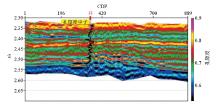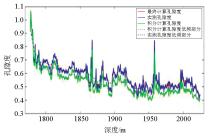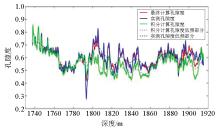|
|
|
| Hydrate identification based on hydrate indicator |
DENG Wei1,2( ), LIANG Jin-Qiang1,3, ZHONG Tong1, HE Yu-Lin3, MENG Miao-Miao3 ), LIANG Jin-Qiang1,3, ZHONG Tong1, HE Yu-Lin3, MENG Miao-Miao3 |
1. Guangzhou Marine Geological Survey,CGS,Guangzhou 510075,China
2. Key Laboratory of Marine Mineral Resources,Guangzhou Marine Geological Survey,Guangzhou 510075,China
3. Natural Gas Hydrate Engineering Technology Center,CGS,Guangzhou 510700,China |
|
|
|
|
Abstract Compared with the post-stack inversion,coupling features in impedance are complex.The pre-stack inversion can make full use of the information such as the amplitude and travel time and frequency of the prestack seismic data,more diverse logging data and geology,and yields geophysical parameters that are highly correlated with hydrate saturation.Seismic rock physics modeling of hydrate reservoirs is the basis for hydrate-oriented prestack inversion.Considering the microscopic pore structure and composition characteristics of hydrate reservoir rocks,this paper introduces SCA-DEM rock physics modeling methods.The influence of physicochemical parameters on the elastic characteristics of rock and its role in AVO characteristics are analyzed.The geophysical response of hydrates is discussed and a new hydrate seismic indicator is constructed.Seismic rock physics analysis shows that the indicator has a high correlation with hydrate saturation.Then,the seismic reflection equation based on hydrate indicator is derived and the feasibility analysis of the inversion is carried out. Finally, based on geological prior, we get the indicator using the actual pre-stack data and logging data in the Qiongdongnan sea of South China Sea.The real data application shows that the method has certain practicability and scientificity.
|
|
Received: 13 November 2019
Published: 01 March 2021
|
|
|
|
|
|

|
Log data of a typical hydrate-bearing well in Qiongdongnan area of South China Sea
|

|
Modeling results with corresponding hard porosity
|

|
Velocity corresponding to different gas saturation and hydrate saturation when porosity is 45%
a—P-velocity corresponding to different gas saturation and hydrate saturation;b—S-velocity corresponding to different gas saturation and hydrate saturation
|

|
Velocity corresponding to different gas saturation and porosity
a—P-velocity corresponding to different gas saturation and porosity;b—S-velocity corresponding to different gas saturation and porosity
|

|
Velocity corresponding to porosity at different gas saturations
a—P-velocity corresponding to different porosity;b—S-velocity corresponding to different porosity
|

|
Typical high saturation hydrate and P-velocity corresponding to porosity with a no hydrate-bearing well in Qiongdongnan area of South China Sea
a—P-velocity corresponding to porosity in w1 well;b—S-velocity corresponding to porosity in w2 well
|

|
Modeled AVO at the hydrate top and bottom
a—AVO at the hydrate top;b—AVO at the hydrate bottom
|

|
AVO at the hydrate top and bottom in w3 well
a—AVO at the hydrate bottom;b—AVO at the hydrate top
|

|
Relation between hydrate saturation and porosity
a—relation between hydrate stauration and porosity in w2 well;b—relation between hydrate stauration and porosity in w3 well
|

|
Crossplots of Fp and P-velocity and P-impedance in w2 well
a—crossplot of Fp and P-velocity;b—crossplot of Fp and P-impedance
|

|
Flow chart of hydrate indicator inversion
|

|
The target seismic section in Qiongdongnan area
a—small angle partial angle stack seismic data(1°~10°);b—middle angle partial angle stack seismic data(11°~20°);c—big angle partial angle stack seismic data(21°~30°)
|

|
Inverted results of porosity
|
v?p(a) and (b)
">

|
Inverted results of (a) and (b)
|

|
Inverted results of Fp
|

|
Relation between P-impedance and porosity reflection coefficient in Qiongdongnan area of South China Sea
a—relation between P-impedance and porosity in w1 well;b—relation between P-impedance and porosity in w2 well
|

|
Inverted porosity in w1 well
|

|
Inverted porosity in w2 well
|
| [1] |
Dickens G R, Quinby H M S. Methane hydrate stability in seawater[J]. Geophysical Research Letters, 1994,21(19):2115-2118.

|
| [2] |
Kvenvolden K A. Gas hydrates:Geological perspective and global change[J]. Review in Geophysics, 1993,31:173-187.
|
| [3] |
Collett T S. Gas hydrate resources of the United States[G]// Gautier D L,Dolton G L,Takahashi K I,et al.National Assessment of United States Oil and Gas Resources on CD-ROM,U.S., 1995.
|
| [4] |
梁金强, 付少英, 陈芳, 等. 南海东北部陆坡海底甲烷渗漏及水合物成藏特征[J]. 天然气地球科学, 2017,28(5):761-770.
|
| [4] |
Liang J Q, Fu S Y, Chen F, et al. Characteristics of methane leakage and hydrate accumulation in the continental slope of the northeastern South China Sea[J]. Natural Gas Geoscience, 2017,28(5):761-770.
|
| [5] |
杨胜雄, 梁金强, 陆敬安, 等. 南海北部神狐海域天然气水合物成藏特征及主控因素新认识[J]. 地学前缘, 2017,24(4):1-14.
|
| [5] |
Yang S X, Liang J Q, Lu J A, et al. New understanding of gas hydrate accumulation characteristics and main controlling factors in Shenhu sea area in the northern South China Sea[J]. Earth Science Frontiers, 2017,24(4):1-14.
|
| [6] |
郭依群, 杨胜雄, 梁金强, 等. 南海北部神狐海域高饱和度天然气水合物分布特征[J]. 地学前缘, 2017,24(4):24-31.
|
| [6] |
Guo Y Q, Yang S X, Liang J Q, et al. Distribution characteristics of high saturation gas hydrate in Shenhu sea area in the northern South China Sea[J]. Geoscience, 2017,24(4):24-31.
|
| [7] |
Waite W, Helgerud M B, Nur A, et al. Laboratory measurements of compressional and shear wave speeds through methane hydrate[G]// Holder G D,Bishnoi P R. Gas hydrates:Challenges for the future:Annals of the New York Academy of Science, 2000: 1003-1010.
|
| [8] |
Hamilton E L. Geoacoustic modeling of the sea floor[J]. Journal of the Acoustical Society of America, 1980,68:1313-1340.

|
| [9] |
胡高伟, 业渝光, 张剑, 等. 沉积物中天然气水合物微观分布模式及其声学响应特征[J]. 天然气工业, 2010,30(3):120-124.

|
| [9] |
Hu G W, Ye Y G, Zhang J, et al. Microscopic distribution patterns and acoustic response characteristics of natural gas hydrates in sediments[J]. Natural Gas Industry, 2010,30(3):120-124.

|
| [10] |
胡高伟, 李承峰, 业渝光, 等. 沉积物孔隙空间天然气水合物微观分布观测[J]. 地球物理学报, 2014,57(5):1675-1682.

|
| [10] |
Hu G W, Li C F, Ye Y G, et al. Microscopic distribution observation of gas hydrate in sediment pore space[J]. Chinese Journal of Geophysics, 2014,57(5):1675-1682.

|
| [11] |
潘豪杰, 刘堂晏, 邬龙, 等. 天然气水合物赋存形态识别及其饱和度预测[J]. 地球物理学进展, 2014,29(4):1735-1740.

|
| [11] |
Pan H J, Liu T Y, Wu L, et al. Gas hydrate occurrence pattern recognition and saturation prediction[J]. Progress in Geophysics, 2014,29(4):1735-1740.

|
| [12] |
Helgerud M B, Dvorkin J, Nur A, et al. Elastic-wave velocity in marine sediments with gas hydrates:Effective medium modeling[J]. Geophysical Research Letters, 1999,26:2021-2024.

|
| [13] |
Sava D, Hardage B. Rock-physics characterization of hydrate-bearing deepwater sediments[J]. The Leading Edge, 2006,25:616-619.

|
| [14] |
Domenico S N. Effect of brine-gas mixture on velocity in an unconsolidated sand reservoir[J]. Geophysics, 1976,41:882-894.

|
| [15] |
王秀娟, 吴时国, 王吉亮, 等. 南海北部神狐海域天然气水合物分解的测井异常[J]. 地球物理学报, 2013,56(8):2799-2807.

|
| [15] |
Wang X J, Wu S G, Wang J L, et al. Logging anomalies of natural gas hydrate decomposition in the Shenhu sea area in the northern South China Sea[J]. Chinese Journal of Geophysics, 2013,56(8):2799-2807.

|
| [16] |
Wang Z. Fundamentals of seismic rock physics[J]. Geophysics, 2012,66(2):398-412.

|
| [17] |
Chatterjee R, Singha D K, Ojha M, et al. Porosity estimation from pre-stack seismic data in gas-hydrate bearing sediments, Krishna-Godavari basin,India[J]. Journal of Natural Gas Science and Engineering, 2016,33:562-572.

|
| [18] |
Kumar R, Das B, Chatterjee R, et al. A methodology of porosity estimation from inversion of post-stack seismic data[J]. Journal of Natural Gas Science and Engineering, 2016,28(1):356-364.

|
| [19] |
Lee M W, Collett T S. In-situ gas hydrate saturations estimated from various well logs at Mount Elbert well, North Slope of Alaska[J]. Marine and Petroleum Geology, 2011,28:439-449.

|
| [20] |
Yin X Y, Zong Z Y, Wu G C. Research on seismic fluid identification driven by rock physics[J]. Science China Earth Sciences, 2015,58(2):159-171.

|
| [21] |
Aki K, Richards P G. Quantitative seismology[M]. California:University Science Books, 2002.
|
| [22] |
Shuey R T. A simplification of the Zoeppritz equations[J]. Geophysics, 1985,50(4):609-614.

|
| [23] |
Smith G C, Gidlow P M. Wighted stacking for rock property estimation and detection of gas[J]. Geophysical Prospecting, 1987,35(9):992-1014.
|
| [24] |
Fatti J L, Smith G C, Vail P J, et al. Detection of gas in sandstone reservoirs using AVO analysis:A 3-D seismic case history using the Geostack technique[J]. Geophysics, 1994,59(9):1362-1376.

|
| [25] |
Russell B H, Gray D, Hampson D P. Linearized AVO inversion and poroelasticity[J]. Geophysics, 2011,76(3):C19-C29.

|
| [26] |
Yin X Y, Zhang S X. Bayesian inversion for effective pore-fluid bulk modulus based on fluid-matrix decoupled amplitude variation with offset approximation[J]. Geophysics, 2014,79(5):R221-R232.

|
| [27] |
Connolly P. Elastic impedance[J]. The Leading Edge, 1999,18(4):438-452.

|
| [28] |
邓炜, 印兴耀, 宗兆云. 基于等效流体体积模量直接反演的流体识别方法[J]. 石油地球物理勘探, 2017,52(2):315-325.
|
| [28] |
Deng W, Yin X Y, Zong Z Y. Fluid identification method based on direct inversion of equivalent fluid volume modulus[J]. Oil Geophysical Prospecting, 2017,52(2):315-325.
|
| [29] |
沙志彬, 万晓明, 赵忠泉, 等. 叠前同时反演技术在珠江口盆地西部海域天然气水合物储层预测中的应用[J]. 物探与化探, 2019,43(3):476-485.

|
| [29] |
Sha Z B, Wan X M, Zhao Z Q, et al. Application of pre-stack simultaneous inversion technique in gas hydrate reservoir prediction in the western waters of the Pearl River Mouth Basin[J]. Geophysical and Geochemical Exploration, 2019,43(3):476-485.

|
| [30] |
Hill R. A self-consistent mechanics of composite materials[J]. Journal of the Mechanics and Physics of Solids, 1965,13:213-222.

|
| [1] |
ZHANG De-Ming, LIU Zhi-Gang, ZANG Dian-Guang, LIAO Xian-Feng, LIU Zhi-Yi, LIU Guo-Bao. Prediction and identification of gas-bearing properties of tight sandstone reservoirs through simultaneous pre-stack inversion:A case study of block S in Sulige gas field[J]. Geophysical and Geochemical Exploration, 2022, 46(3): 645-652. |
| [2] |
LIU Lan-Feng, YIN Long, HUANG Han-Dong, ZHOU Zhen-Ya, DONG Jin-Chao. Research on the method of shear wave prediction based on rock physics modeling[J]. Geophysical and Geochemical Exploration, 2021, 45(6): 1482-1487. |
|
|
|
|

